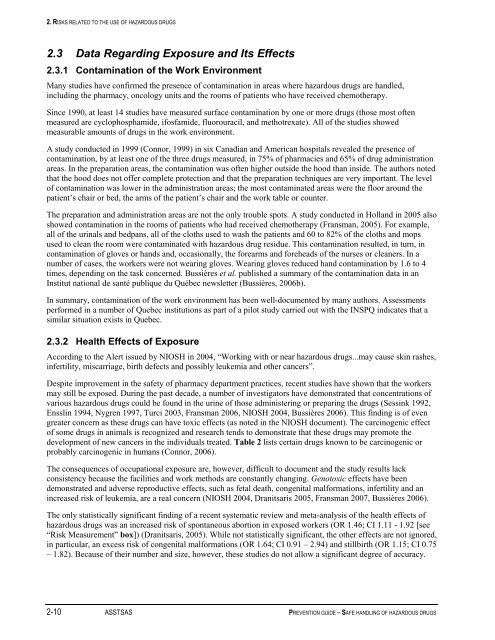Prevention Guide - Safe Handling of Hazardous Drugs - Irsst
Prevention Guide - Safe Handling of Hazardous Drugs - Irsst
Prevention Guide - Safe Handling of Hazardous Drugs - Irsst
Create successful ePaper yourself
Turn your PDF publications into a flip-book with our unique Google optimized e-Paper software.
2. RISKS RELATED TO THE USE OF HAZARDOUS DRUGS<br />
2.3 Data Regarding Exposure and Its Effects<br />
2.3.1 Contamination <strong>of</strong> the Work Environment<br />
Many studies have confirmed the presence <strong>of</strong> contamination in areas where hazardous drugs are handled,<br />
including the pharmacy, oncology units and the rooms <strong>of</strong> patients who have received chemotherapy.<br />
Since 1990, at least 14 studies have measured surface contamination by one or more drugs (those most <strong>of</strong>ten<br />
measured are cyclophosphamide, ifosfamide, fluorouracil, and methotrexate). All <strong>of</strong> the studies showed<br />
measurable amounts <strong>of</strong> drugs in the work environment.<br />
A study conducted in 1999 (Connor, 1999) in six Canadian and American hospitals revealed the presence <strong>of</strong><br />
contamination, by at least one <strong>of</strong> the three drugs measured, in 75% <strong>of</strong> pharmacies and 65% <strong>of</strong> drug administration<br />
areas. In the preparation areas, the contamination was <strong>of</strong>ten higher outside the hood than inside. The authors noted<br />
that the hood does not <strong>of</strong>fer complete protection and that the preparation techniques are very important. The level<br />
<strong>of</strong> contamination was lower in the administration areas; the most contaminated areas were the floor around the<br />
patient’s chair or bed, the arms <strong>of</strong> the patient’s chair and the work table or counter.<br />
The preparation and administration areas are not the only trouble spots. A study conducted in Holland in 2005 also<br />
showed contamination in the rooms <strong>of</strong> patients who had received chemotherapy (Fransman, 2005). For example,<br />
all <strong>of</strong> the urinals and bedpans, all <strong>of</strong> the cloths used to wash the patients and 60 to 82% <strong>of</strong> the cloths and mops<br />
used to clean the room were contaminated with hazardous drug residue. This contamination resulted, in turn, in<br />
contamination <strong>of</strong> gloves or hands and, occasionally, the forearms and foreheads <strong>of</strong> the nurses or cleaners. In a<br />
number <strong>of</strong> cases, the workers were not wearing gloves. Wearing gloves reduced hand contamination by 1.6 to 4<br />
times, depending on the task concerned. Bussières et al. published a summary <strong>of</strong> the contamination data in an<br />
Institut national de santé publique du Québec newsletter (Bussières, 2006b).<br />
In summary, contamination <strong>of</strong> the work environment has been well-documented by many authors. Assessments<br />
performed in a number <strong>of</strong> Quebec institutions as part <strong>of</strong> a pilot study carried out with the INSPQ indicates that a<br />
similar situation exists in Quebec.<br />
2.3.2 Health Effects <strong>of</strong> Exposure<br />
According to the Alert issued by NIOSH in 2004, “Working with or near hazardous drugs...may cause skin rashes,<br />
infertility, miscarriage, birth defects and possibly leukemia and other cancers”.<br />
Despite improvement in the safety <strong>of</strong> pharmacy department practices, recent studies have shown that the workers<br />
may still be exposed. During the past decade, a number <strong>of</strong> investigators have demonstrated that concentrations <strong>of</strong><br />
various hazardous drugs could be found in the urine <strong>of</strong> those administering or preparing the drugs (Sessink 1992,<br />
Ensslin 1994, Nygren 1997, Turci 2003, Fransman 2006, NIOSH 2004, Bussières 2006). This finding is <strong>of</strong> even<br />
greater concern as these drugs can have toxic effects (as noted in the NIOSH document). The carcinogenic effect<br />
<strong>of</strong> some drugs in animals is recognized and research tends to demonstrate that these drugs may promote the<br />
development <strong>of</strong> new cancers in the individuals treated. Table 2 lists certain drugs known to be carcinogenic or<br />
probably carcinogenic in humans (Connor, 2006).<br />
The consequences <strong>of</strong> occupational exposure are, however, difficult to document and the study results lack<br />
consistency because the facilities and work methods are constantly changing. Genotoxic effects have been<br />
demonstrated and adverse reproductive effects, such as fetal death, congenital malformations, infertility and an<br />
increased risk <strong>of</strong> leukemia, are a real concern (NIOSH 2004, Dranitsaris 2005, Fransman 2007, Bussières 2006).<br />
The only statistically significant finding <strong>of</strong> a recent systematic review and meta-analysis <strong>of</strong> the health effects <strong>of</strong><br />
hazardous drugs was an increased risk <strong>of</strong> spontaneous abortion in exposed workers (OR 1.46; CI 1.11 - 1.92 [see<br />
“Risk Measurement” box]) (Dranitsaris, 2005). While not statistically significant, the other effects are not ignored,<br />
in particular, an excess risk <strong>of</strong> congenital malformations (OR 1.64; CI 0.91 – 2.94) and stillbirth (OR 1.15; CI 0.75<br />
– 1.82). Because <strong>of</strong> their number and size, however, these studies do not allow a significant degree <strong>of</strong> accuracy.<br />
2-10 ASSTSAS PREVENTION GUIDE – SAFE HANDLING OF HAZARDOUS DRUGS

















